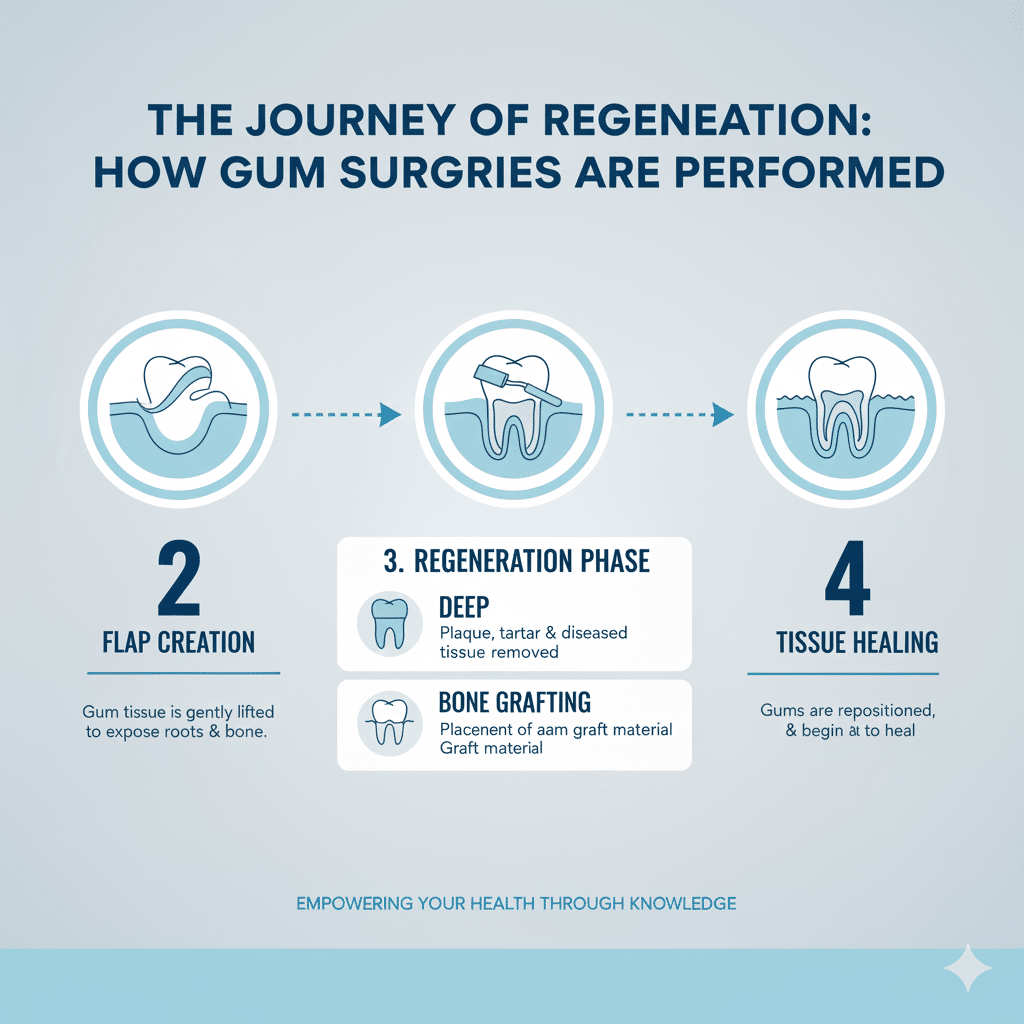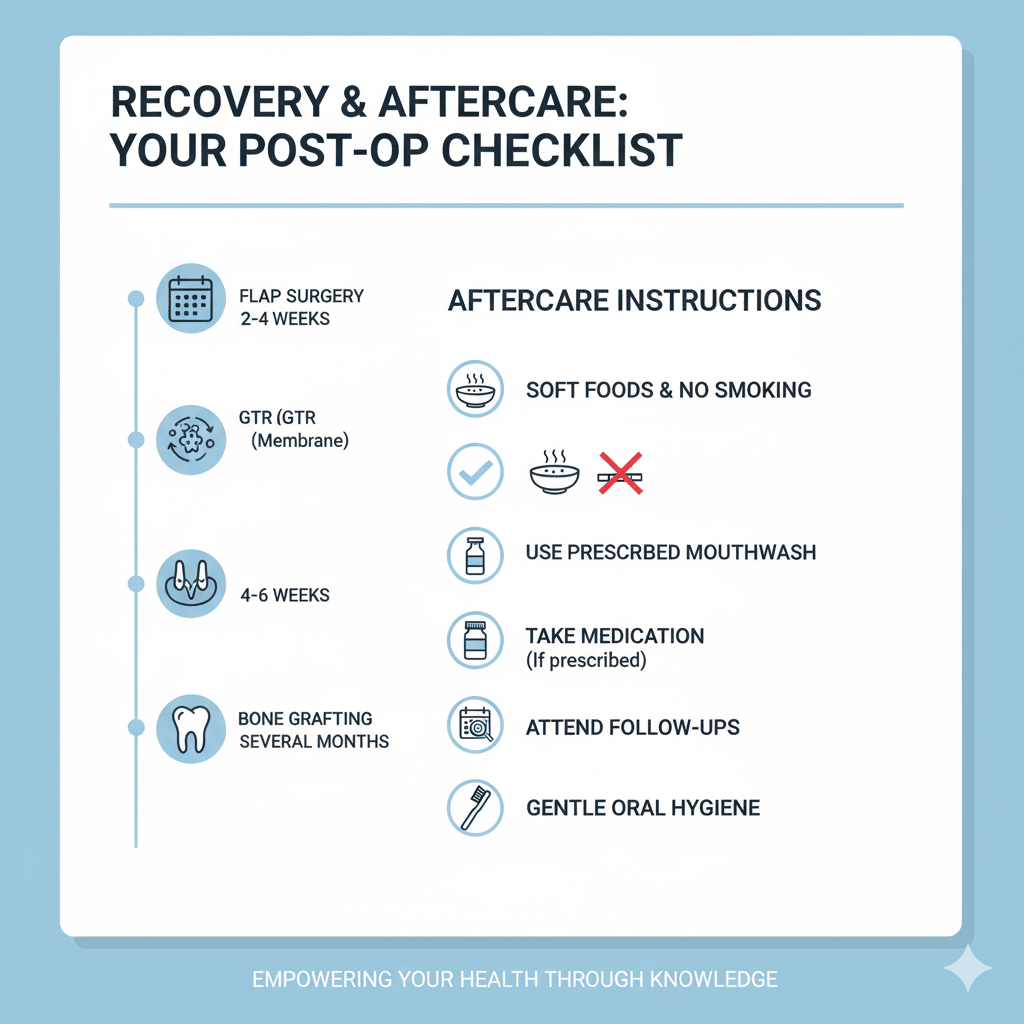Flap & Regenerative Surgeries in Periodontics: Advanced Solutions for Gum Health
Introduction
When gum disease progresses beyond the early stage of gingivitis, it begins to silently damage the tissues that hold your teeth in place. Left untreated, this condition—called periodontitis—can cause bone loss, loose teeth, and eventually tooth loss. Unfortunately, no toothpaste or mouthwash can reverse advanced periodontitis once it sets in.
This is where flap and regenerative periodontal surgeries play a vital role. These advanced procedures allow periodontists to go below the gumline, clean out harmful bacteria, and even regrow lost bone and tissue. At Tooth Crew Clinic, Islamabad, we specialize in flap surgery, guided tissue regeneration, and bone grafting to restore both oral health and confidence.
This article is your complete guide to these treatments—what they are, why they’re needed, how they work, their costs, recovery time, and frequently asked questions.
What Are Flap & Regenerative Surgeries?
Flap and regenerative surgeries are advanced treatments for patients with moderate to severe periodontal disease. Unlike basic scaling and root planing (deep cleaning), these procedures involve lifting the gum tissue to clean underneath and, in many cases, stimulate the regrowth of bone and connective tissue.
They are called “regenerative” because they aim to reverse the damage caused by gum disease—not just control it.
Types of Flap & Regenerative Surgeries
1. Periodontal Flap Surgery
This is the most common surgical treatment for periodontitis.
- What it is: The gums are gently lifted away from the teeth to expose the roots and bone. This allows the periodontist to remove tartar, bacteria, and diseased tissue that lie deep below the gumline.
- When it’s needed:
- Deep periodontal pockets (>5mm) that cannot be cleaned with non-surgical methods.
- Persistent gum inflammation despite scaling and antibiotics.
- Early bone loss around teeth.
- Benefits: Reduces pocket depth, saves natural teeth, and makes gums easier to clean in the future.
2. Guided Tissue Regeneration (GTR)
Gum disease doesn’t just destroy gums—it also damages the bone that holds teeth in place. Guided tissue regeneration is a revolutionary technique that encourages the body to rebuild these lost tissues.
- What it is: A special barrier membrane is placed between the gum and bone defect. This membrane prevents gum tissue from growing into the bone area, giving bone cells the chance to regrow.
- When it’s needed:
- Significant bone loss around teeth.
- Teeth at risk of becoming loose.
- As part of regenerative therapy combined with bone grafting.
- Benefits: Restores natural bone support, improves tooth stability, and may prevent tooth extraction.
3. Bone Grafting for Periodontal Defects
When gum disease has caused severe bone loss, regeneration is impossible without bone support. That’s where bone grafting comes in.
- What it is: The periodontist places grafting material (either natural or synthetic) into the bone defect. This acts as a scaffold for new bone to grow.
- Sources of bone graft material:
- Autograft (patient’s own bone)
- Allograft (donor bone)
- Xenograft (animal source, e.g., bovine)
- Synthetic grafts (biocompatible materials)
- When it’s needed:
- Teeth with severe bone defects.
- Before placing dental implants.
- To support GTR and other regenerative surgeries.
- Benefits: Rebuilds lost bone, strengthens tooth support, and improves long-term oral health.
Comparison of Procedures
| Feature | Flap Surgery | Guided Tissue Regeneration | Bone Grafting |
| Main Goal | Cleaning deep pockets | Regrow bone & tissue | Replace lost bone |
| When Used | Moderate–severe gum disease | Severe bone loss | Severe periodontal defects / implant prep |
| Materials Used | None (cleaning only) | Barrier membranes | Graft material (natural/synthetic) |
| Healing Time | 2–4 weeks | 4–6 weeks | 6–9 months (bone maturation) |
| Permanence | Reduces disease progression | Can restore lost bone | Provides structural foundation |
How the Surgeries Are Performed
Step-by-Step Overview
- Diagnosis & Imaging: Dental X-rays or 3D scans identify bone loss.
- Anesthesia: Local anesthesia ensures comfort.
- Flap Creation: Gum tissue is gently lifted to expose roots and bone.
- Deep Cleaning: Plaque, tartar, and diseased tissue are removed.
- Regeneration Phase:
- GTR → placement of barrier membranes.
- Bone grafting → placement of graft material.
- Suturing: Gums are repositioned and stitched back.
- Healing: Regular checkups ensure proper regeneration.
Patient Benefits of Regenerative Surgeries
Unlike traditional gum treatments, which only slow down the disease, regenerative surgeries offer life-changing benefits:
- Preserve natural teeth that might otherwise be lost.
- Stimulate bone growth for long-term dental stability.
- Reduce the need for extractions and implants.
- Improve gum health and oral hygiene maintenance.
- Enhance smile aesthetics by restoring natural contours.
Recovery & Aftercare
Recovery times vary depending on the type of surgery.
- Flap surgery: Healing within 2–4 weeks.
- GTR: About 4–6 weeks, with gradual tissue regeneration.
- Bone grafting: Several months for bone to fully mature.
Aftercare instructions:
- Eat soft foods for the first few days.
- Avoid smoking and alcohol.
- Use prescribed mouth rinses.
- Take antibiotics (if prescribed).
- Attend all follow-up appointments.
Risks & Safety
While generally safe, these procedures have potential risks:
- Temporary swelling and discomfort.
- Minor bleeding.
- Infection if aftercare is neglected.
- Graft rejection (rare).
At Tooth Crew Clinic Islamabad, we minimize these risks by using sterilized instruments, advanced imaging, and personalized patient care.
Cost of Flap & Regenerative Surgeries
| Procedure | Cost in Islamabad (PKR) | Cost in USA (USD) | Cost in UK (GBP) |
| Flap Surgery | 25,000 – 45,000 | $800 – $1,500 | £600 – £1,200 |
| GTR | 35,000 – 70,000 | $1,200 – $3,000 | £1,000 – £2,500 |
| Bone Grafting | 40,000 – 90,000 | $1,500 – $4,000 | £1,200 – £3,000 |
👉 Takeaway: Patients in Islamabad can access world-class regenerative periodontal surgery at a fraction of the international cost.
Frequently Asked Questions
- Is flap surgery painful?
Not during the procedure (local anesthesia is used). Some soreness may occur afterward, manageable with pain relief. - How long does a bone graft last?
If successful, bone grafts integrate permanently with your natural bone. - Can I avoid flap surgery with deep cleaning only?
No. Deep cleaning helps in early gum disease, but advanced cases require flap access. - Is GTR always successful?
Success rates are high, but outcomes depend on patient health, oral hygiene, and smoking status. - Can these surgeries save loose teeth?
Yes, in many cases regenerative surgery stabilizes teeth that might otherwise be lost.
Why Choose Tooth Crew Clinic for Regenerative Surgeries in Islamabad?
- Expert periodontists with specialized surgical training.
- Advanced technologies including digital X-rays, laser-assisted surgery, and biocompatible grafts.
- Affordable treatment plans tailored for every patient.
- Trusted care with a strong reputation in Islamabad’s dental community.
Conclusion
Flap and regenerative periodontal surgeries—flap surgery, guided tissue regeneration, and bone grafting—represent the cutting edge of gum disease treatment. They don’t just stop disease; they help rebuild what has been lost.
At Tooth Crew Clinic Islamabad, we are committed to saving natural teeth and restoring oral health through these advanced techniques. Whether you’re struggling with deep periodontal pockets, bone loss, or loose teeth, our team provides safe, effective, and affordable solutions.
📞 Contact us today to schedule a consultation and take the first step toward stronger gums and a healthier smile.



